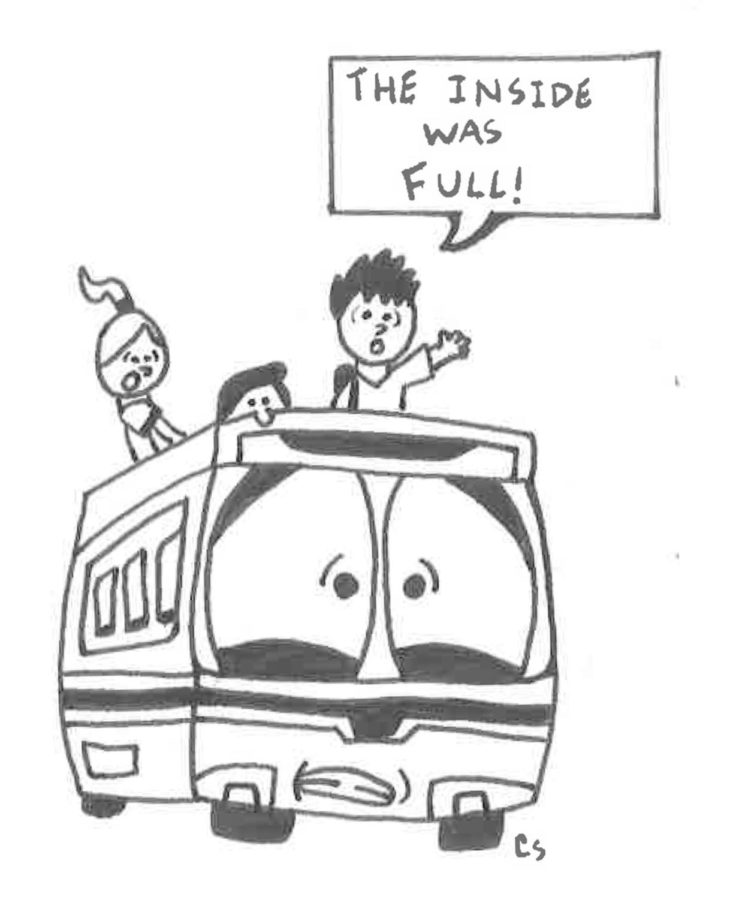Titus: Stuffing the bus to the brim
Cyride illustration
February 21, 2014
When standing at the bus stop outside of Maple-Willow-Larch only three short years ago, catching a bus would be the least of my worries. There was a bus coming about every three minutes on the 23 Orange route, and there would still be room for me to get on at any time of day. This seems to no longer be the case.
Buses are fuller than they have ever been, but that is not stopping bus drivers from letting students on. During the busy hours of the day, buses have been so full that many of them (Orange route especially) have been unable to pick people up at the later stops, such as Carver Hall and the Memorial Union.
Orange and 21 Cardinal circulator routes are not the only ones that have been struggling to keep up with the flood of students trying to get onto the buses. Routes that come to each stop less frequently are having the same trouble. If you are trying to catch a bus on one of the less frequent routes such as 6 Brown South, 2 Green or 7 Purple and you miss the bus because it is too full, it is going to be a while before you can catch another one.
Students who depend on the buses are going to have to miss class or get home late if they are unable to pick them up. This is causing bus drivers to allow more people on the buses than allowed.
Bus drivers seem to be letting on more students than can fit comfortably. Students are not supposed to stand in front of the yellow line on the bus as part of the safety precautions. Each bus has a capacity that they are required to follow and most the time on the bus, we are clearly over. However, many of the buses I have gotten have students standing on the stairs. Accommodations should be made.
We have more buses running now than we have ever in the past, but with students in record attendance, there is still a need for even more. Buses are extremely expensive. Last time Cyride purchased more buses they spent over a million dollars. That is a big chunk of change, but could be worth it to ensure everyone will be able to ride the bus, after all we are helping pay for those costs on our Ubills. More of the busier campus routes should have two buses running the same route, one following the other. This way if one bus is drop off only, the other bus will be able to pick students up.
Waiting for a bus that can pick you up is a major part of the struggle. Most people are trying to take the bus because it can get them to their classes faster than they would be able to get to them by walking. Now that students are waiting for multiple buses to pass by before they can get on, it would be faster to walk to class.
The same situation goes for how early the buses stop running on the regular route. Yes, we understand that it is expensive to run the buses, but if there is still a large demand for students to catch a bus at 6 p.m., then the buses should still be running regularly at that time to be able to pick students up. Early morning classes are experiencing the same problems. Now that there are more students on campus, there is a larger demand for more CyRide buses for those early classes.
On the other hand, CyRide does a lot for us. It usually gets us to class on time, it brings us home after a crazy weekend a little too far from home to walk and it helps us avoid spending too much time out in the elements. CyRide is doing everything it can to be able to keep up with the overload of students joining the ISU campus every year. However, the more students that come onto campus, the more buses we are going to need. It is time to start planning ahead for the years to come so that we can continue to get students from place to place as safely and timely as possible.
In no form am I trying to say that we do not appreciate CyRide and the fact that it can quickly get us from class to class when it is raining and snowing. The CyRide drivers do everything they can to not have to leave any students behind at the stops. Unfortunately, there is just not enough room for all of those students on the buses. Safety first.







